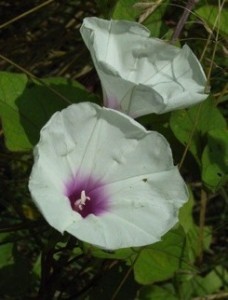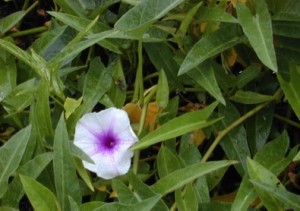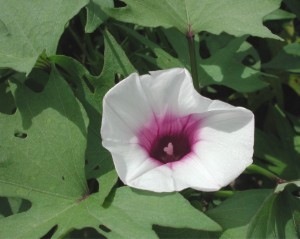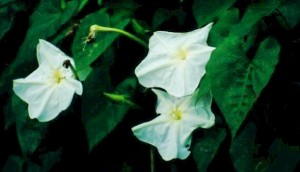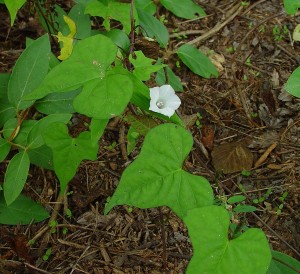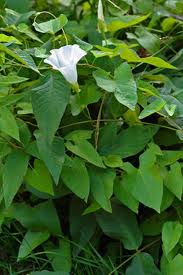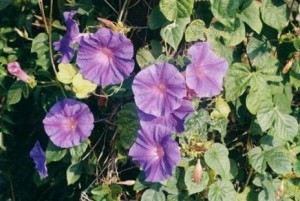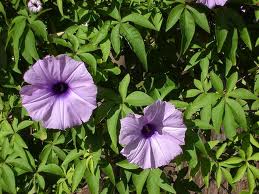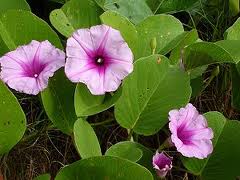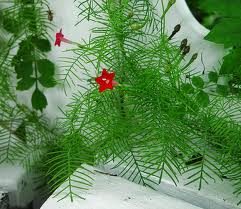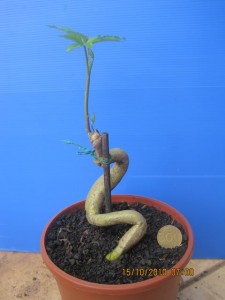Glorifying Morning Glories
Three of the pictures below are are not of the same Ipomoea. It’s three different species, but that should tell you something. When you see a Morning Glory species with a large, white blossom and a ruby throat it is worth investigating. Large white Morning Glories flowers without ruby throats are worth investigating, too. Other color blossoms are more iffy.
A word of warning: There are several edible and several inedible Morning Glories and impostors. They can all be easily sorted out so do your homework. When you find a possible edible take a picture and research it!
Ipomoea pandurata (eep-oh-MEE-uh pand-yoor-RAY-tuh, shaped like a fiddle) is native to Florida and the eastern half of North America. It has a large root that can be eaten if cubed and boiled in at least two changes of water. Never eat it raw. It is also called Wild Potato Vine and “Man of the Earth” because it can create huge roots. Younger and smaller is better. Young roots can also be roasted but they will be on the bitter side. Boiling twice is the preferred method, then roast the boiled cubes if you like. Usually straight down deep from where the vine goes into the ground you will find the root. Yard-long roots weighing 25 pounds are possible. But, they get more acrid the older they get so if you can find an big old one you might want to let it be and look for a smaller younger one nearby.
I looked for I. pandurata for many years before I found one, being constantly misled by the iffy Alamo Vine. My friend and teacher, Dick Deuerling spoke of the I. pandurata often but all I ever saw was the very common Alamo Vine. Then one day while on the Orange County Bike Trail near Chapin Station there it was (such moments are important and remembered.) Now I see them often. Leaves are heart-shaped.
The I. pandurata has two similar looking plants. They have white flowers as well. The key to sorting them out are the leaves and flower size. The aforementioned Alamo Vine (Merremia dissecta) has small white flowers with a ruby throat and very dissected leaves that are shaped like fingers on a hand, read palmate. While not edible per se the Merremia dissecta is not totally with out some good features. It has been used as a condiment and for medicinal needs. Leaf extracts have an almond flavor from amygdalin, a cyanide precursor also called natural laetrile. Needless to say it can be toxic stuff if handled poorly either as a flavoring or a medicine. I offer no instruction on that. Crush a leaf and smell it. If you smell almonds you have the M. dissecta. That said, the young roots of a relative, Merremia dissecta var. edentata, are cooked and eaten but it only grows in central South America. The M. dissecta edentata leaves are not toothy and the flower’s throat is not ruby. The name Merremia may be from the name Miriam, meaning Mary, or Virgin Mary plant, said me-REE-mee-uh. Dissecta is said dy-SEK-tuh and means dissected. Edentata, e-DEN-tay-tuh, is toothless.
Our next Morning Glory on the white and ruby line up is Ipomoea aquatica, (eep-oh-MEE-uh a-KWA-ti-ka, water loving.) It’s a native of China called “water spinach.” If you do find it, depending where you live, you’re expected to report it because it grows aggressively. Where fresh water doesn’t freeze, such as Florida, it is colonizing the waterways. In northern areas, winter keeps it in check.
There are two versions of I. aquatica, narrow leaf and wide leaf, both are edible. And actually they come in two colors. The “green” version has green stems and white flowers with red throats. The “red” version has purple-tinged stems with pink or lilac flowers with red throats. They both grow only in water, or very damp soil. The vines, with milky sap, can reach up to 70-feet long (the state of Florida says only nine feet.) Shoots and leaves are the edible parts. You will not find this in dry areas.
Recognized as a potential problem in Florida since the 1950s, I. aquatica has been introduced into the state several times since 1979 by various Asian communities. It is raised as a vegetable in Florida under strict conditions and only for out-of-state sale. It is also cultivated in Texas, Hawaii and California. In the United States it is found in the wild in (mostly central west) Florida, Hawaii and Puerto Rico.
Should you find it do your best to stop its spread by devouring said. It’s the civic thing to do. It can be eaten raw when found in wholesome water. Otherwise, it should be cooked. The leaves are 48% carbohydrates, 24% proteins, 13% ash. They are rich in minerals and a good source of vitamins A, C and E. It is a major food crop and vegetable in the Orient. The roots are sometimes eaten. Like other members of this family, they are toxic to horses.
Our third similar Morning Glory is the common cultivated Sweet Potato, Ipomoea batatas (eep-oh-MEE-uh bah-TAY-tas.) As we already know the root is edible but so are the leaves, cooked like a green. There’s a huge variety of them you can raise. More so, in the winter time if you have a sunny window, you can put a root in partial water and will will grow greens for you through the winter. The Sweet Potato is mistakenly called yams.. well… that’s not originally true. More than a century ago the marketing decision was made to call Sweet Potatoes “yams” because true yams, of the Discorea genus, were widely eaten. That moved into common language and now, wrongly, the Sweet Potates are sold as yams and true yams are sold as yams, but rarely canned in this country. To make things worse in other countries the root of the edible Oxalis tuberosa, is also called a yam.
Another white and red combo is rare so no picture, Ipomoea macrorhiza (large root) a perennial vine from large tuber. The rare night-flowering morning glory is found in coastal areas of the southeastern US. It was presumably introduced from the Yucatan by aboriginal inhabitants before Columbus. Found on Indian shell middens, large roots were cooked, might be edible raw. Plant has attractive crinkled foliage and large white to pale pink flowers which bloom at night like moonflower, which is up next.
We keep the large white flower but abandon the ruby throat. We have two examples which are very similar. The first is Ipomoea alba (eep-oh-MEE-uh AL-buh, white) a night-blooming morning glory with a very fragrant, luxurious flower. Its sepals are mucronate ( that is having a fine point often rising abruptly at the tip.) Note it is a white flower without any color in the throat — okay a little yellow maybe — though it has a five-star like greenish wrinkling or folding on the top of the blossom, technically called midpetaline bands. The leaves are heart-shaped. Nicknamed, Moonflower, the young leaves and fleshy calyces are edible when cooked. They can be boiled or steamed. They can also be dried for later use. Seeds edible when young. Incidentally, it takes the flower about a minute to open. It is also sometimes called Calonyction album. The raw leaves can be used like soap. Looking nearly identical is the Ipomoea tuba, (eep-oh-MEE-uh TOO-bah
I. tuba, aka Beach Moonflower, has has thicker leaves than the I. alba and likes a coastal environment, such as mangrove swamps. It is used the same was as I. alba. I. tuba is found from about St. Petersburg Fl. south on the west coast of Florida. To help identify it from the I. alba where their range overlap the sepals of the I. tuba are NOT pointed but are round and blunt. Incidentally the white sap of the I. alba and I. tuba might cause dermatitis and was used in the early rubber-making process. “Tuba” in Dead Latin means trumpet. Ipomoea macrantha (ma-cra-ANN-tha, large flowered) not pictured, also looks similar to I. alba and can be used the same way as I. alba.
Do you remember the first Ipomoea in this article, the I. pandurata, the Wild Potato Vine? The Whitestar Potato is similar except small white flowers and heartshaped leaves. The cooked root of the Ipomoea lacunosa, was eaten by American Indians in central and eastern North America and California. Also consumed were the young roots of the Ipomoea leptophylla , boiled or roasted. Roots over three-years-old were not eaten. I. plummerae (which has grass-like leaves) was another cooked root food of the Amerindians.
The Hedge Bindweed (Calystegia sepium) has small white flowers often without a red throat. It has triangle shaped leaves and climbs counter clockwise. The bindweed stalks, young shoots and root are edible cooked, green parts steamed or boiled, roots boiled. However, it can be purgative so regular eating of said is not recommended. The name is from the Greek kalyx (calyx) and stegon (cover), referring to the bracts that conceal the calyx, pronounced kal-ee-STEE-jee-uh or kal-ee-STEG-ee-uh. Sepium, SEE-pee-um, of the hedges. The blossoms can also have a pinkish tinge.
The Ipomoea violacea (vye-o-LAY-see-uh, violet) is a bit of a chameleon, it can range in color from white to blue under cultivation (aka Ipomoea tricolor) but in the wild it tends to be violet. It’s used the same way as the I. alba, that is young leaves and fleshy calyces are edible when cooked. They can be boiled or steamed. They can also be dried for later use. Seeds edible when young, cooked. Raw leaves can be used like soap. This is the Morning Glory of drug culture fame. The raw seeds have a little amount of a crude form of LSD.
Ipomoea cairica, (KY-rik-uh, from Cairo) is naturalized from Africa. Called the Mile-A-Minute-Vine it has edible roots and stems though they are slightly bitter and both are slightly cyanogenetic. Its flowers range from violet-purple to light pink to white with a pink or red throat. The leaves while called ivy-like look more palm-like to me with deep lobes of five to seven. Roots were boiled, or, grated then roasted, no doubt to drive off the cyanide. The fruit of the I. cairica (holding the seeds) is used as a soap, just crushed against the skin and water applied. It creates a lather. Animals known to eat the plant raw include giraffes, goats, rabbits, guinea-pigs, and pigs. It is apparently toxic to horses.
Ipomoea pes-caprae (goat foot) or Railroad Vine, Beach Morning Glory and Goat’s Foot Morning Glory, is often found on the sandy seashore. Its cooked roots, stems and leaves can be eaten in small amounts as a famine food. It is extremely common and usually the only Morning Glory found along the eastern shore of Florida, literally on the beach. One of its claims to fame is that it can reach 100 feet long or more.
According to Kew Gardens also eaten are the cooked leaves of the Cypress Vine, Ipomoea quamoclit (KWAH-moe-klit, the Mexican name), though they may make you sleepy and are cyanogenic. They definitely must be boiled. Leaves of the Ipomoea obscura (ob-SCUR-ah, dark) are eaten either in soups or as a cooked vegetable, and leaves of the Ipomoea involucrata are eaten cooked like a green. (in-vol-yoo-KRAY-ta, a reference to its bracts.) Some subspecies are more forgiving on the gastrointestinal track. On the other side of the world the Ipomoea digitata (finger-like) has edible oblong tubers and leaves when cooked. It is not found in the Americas.
There are several hundred species in the Morning Glory group and it is suspected that most of them have edible leaves and other parts. But don’t guess. Check out your local species with an expert.
Seeds of the I. tricolor, I. pandurata, I. nil, I. violacea and I. tuba have been used for their hallucinogenic properties. In the state of Louisiana the I. tuba became illegal in 2005 to cultivate for any purpose other than ornamental. A close relative of the Ipomoea is the Jicama, which has toxic seeds. All part of that plant above ground have high amounts of rotenone, a fish killer.
The genus name, Ipomoea, is mangled Greek via Dead Latin. Ipo is often said to come from Ips and means worm but that’s just linguistic illiteracy among botany professors. To say it means “worm” is stretching it. The basic word is Ipo which means below, beneath or under. Homoios is perverted via Dead Latin as well. The basic word in Greek is omoio not homoios. It means “similarity.” Ipomoea means “resembling underground” as in the sprawl of a root, or perhaps the tunnels of a worm. Batata is going to take some explaining:
When Columbus landed on Haiti the natives there, the Tainos (Arawaks) called the root “batatas” which literally means potato. The Spanish changed that to Patatas. When the Spanish later saw the white potato they called that Patatas as well. That changed in English to potato. So, the white potato was named after the Batatas and became potato but now in English we call Batatas the Sweet Potato. And worse, of course, is calling the Sweet Potato a yam, which it is not. Yams are from a totally different family, the Dioscorea.

